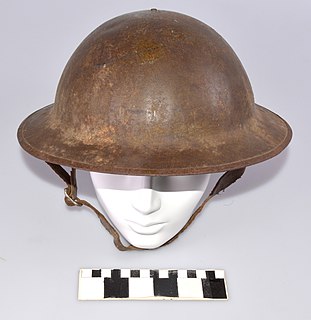
The Brodie helmet is a steel combat helmet designed and patented in London in 1915 by John Leopold Brodie. A modified form of it became the Helmet, Steel, Mark I in Britain and the M1917 Helmet in the US. Colloquially, it was called the shrapnel helmet, battle bowler, Tommy helmet, tin hat, and in the United States the doughboy helmet. It was also known as the dishpan hat, tin pan hat, washbasin, battle bowler, and Kelly helmet. The German Army called it the Salatschüssel. The term Brodie is often misused. It is correctly applied only to the original 1915 Brodie's Steel Helmet, War Office Pattern.

The Stahlhelm is a German military steel combat helmet intended to provide protection against shrapnel and fragments of grenades. The term Stahlhelm refers both to a generic steel helmet and more specifically to the distinctive German military design.

The M1 helmet is a combat helmet that was used by the U.S. military from World War II until 1985, when it was succeeded by the PASGT helmet. The M1 helmet has become an icon of the US military, with its design inspiring other militaries around the world.

The hełm wz. 31 was the basic combat helmet of the Polish Army before the outbreak of World War II and during the Invasion of Poland. The helmet became the basic type of combat headgear for Polish military formations in 1930s and during the early stages of World War II. It was also exported to Persia, Albania and Republican Spain. By September 1939 approximately 320,000 copies were delivered to the Polish Army.

The Mk III Helmet was a steel military combat helmet first developed for the British Army in 1941 by the Medical Research Council. First worn in combat by British and Canadian troops on D-Day, the Mk III and Mk IV were used alongside the Brodie helmet for the remainder of the Second World War. It is sometimes referred to as the "turtle" helmet by collectors, because of its vague resemblance to a turtle shell, as well as the 1944 pattern helmet.
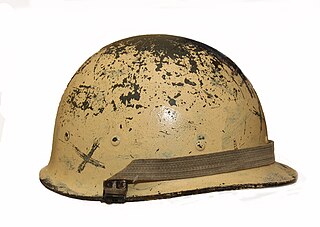
The Iraqi M80 Helmet is a military helmet made of compressed canvas used by the Iraqi Armed Forces from the early 1980s onwards. They were used in the Iran–Iraq War, the Persian Gulf War/Operation Desert Storm, and the 2003 Invasion of Iraq/Operation Iraqi Freedom. These helmets were originally manufactured and designed in South Korea by Hyundai Heavy Department or H.H. Didizian, both are South Korean companies, but in 1990 an Iraqi-made version appeared, which is usually fitted with a distinctive rubber rim. Both types of helmet are still in limited service with the Iraqi Security Forces but are being replaced by the American PASGT helmet.

The SSh-68 - is a steel combat helmet of the Soviet and then Russian Armed Forces. The SSh-68 is a further development of the SSh-60 helmet. It differs primarily in its greater strength, greater front slope of the dome and the shorter outer edge. It is usually painted in dark green.

The SSh-60 (СШ-60 was a product improvement of the Soviet SSh-40 steel helmet of the Soviet Army and entered production around 1960. It was not fundamentally different from the previous World War 2 era SSh-40, the primary difference being an updated liner/suspension system.
The OR-201, also designated Kasda OR-201 Model 76 or M-76 for short, is a combat helmet of Israeli origin. Developed in the 1970s, the OR-201 was one of the world's first ballistic helmets. It was subsequently exported on a large scale and has been used by many militaries worldwide.
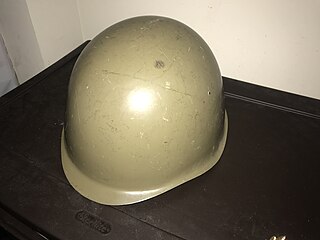
The Czechoslovakian M53 helmet was used by the Czechoslovak Army from the early 1950s onward. In western European countries and the United States, it is sometimes referred to as the Czech M53 helmet. These helmets are commonly mistaken for, and sometimes marketed as, Soviet SSh-40 helmets, and various other very similar Eastern Bloc helmets.

The m/37 helmet is a military steel combat helmet used by Swedish armed forces. Replacing the m/21 helmet, the m/37 would be modernized in 1965 with an updated liner and see use into the 1990s with its replacement by the M1990 Kevlar helmet. Three main variants existed. The first had a three pad liner system, like the m/21 and m/26 before it. The third, most common versions of the modified helmets had the same liner as the pictures but with a canvas chinstrap with a quick-release system. The helmet could be gray, as it always was during the second world war, or painted green as it often, but not always, was during the cold war.

The M32 helmet also known as M32/34 is a military steel combat helmet used by Czechoslovakia from its adoption in 1932 to its annexation by Nazi Germany in 1939. The helmet also being used by the Slovak Republic and Finland among other countries that the helmet would be worn by.

The M1918 helmet is a steel military combat helmet used by Switzerland from its introduction in 1918 to its replacement by the M1971. In 1943 improvements would be made to the design to which it would be called the M1918/40. The helmet would be seen used by Swiss servicemen until the late 20th century.

The M1971 helmet is a military steel combat helmet used by Switzerland from its formal introduction in 1971 until its gradual replacement by the Schuberth B826.

The M1942 helmet is a military steel combat helmet used by Spain from its adoption in 1942 to its replacement by a Spanish M1 copy in the 1980s.
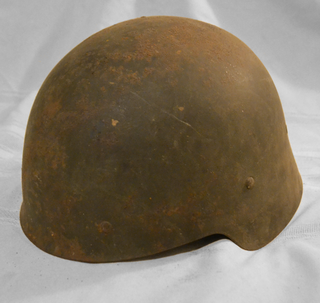
The M1921 Helmet, is a steel combat helmet developed alongside the M1926 helmet in 1926 for use by the Spanish Army. The model was never formally adopted, with the army deciding in favor of the M1926. The exact reasoning for the designation "M1921" is not known as it was developed later.

The M1934 helmet is a steel combat helmet used by various factions in the Spanish Civil War. Meant not for use by the Army, but instead by security forces such as police, the helmet was of similar shape to the Model 1926 helmet in use by the army. The helmet would mainly see use by the Nationalists in the conflict.
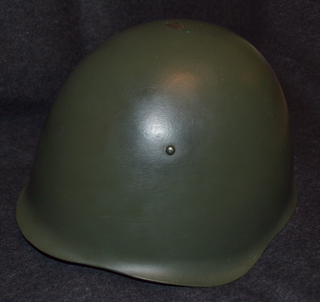
The Wz50 also known as M50 is a steel combat helmet used by Poland from its introduction in 1950 to its replacement by the Wz67 in 1967. The helmet would be widely exported to a number of Arab countries for its low price. Early pre-production helmets by a double riveted chinstrap and cow skin leather liner. All models of helmet would include an maker and manufacture stamp

The M34 is a steel combat helmet used by the Netherlands from its introduction in 1934 replacing the previous M23/27, to the invasion by Nazi Germany in 1940. From which it was replaced by the M53 helmet, a local copy of the American M1 helmet. A tropical variant of this helmet was produced for use by the Dutch East India Army in present-day Indonesia known as the KNIL model.
The SSh-39 and SSh-40 were two similar designs of steel combat helmet designed and used by the Soviet Union's Red Army. They were the main forms of helmet in use during World War II and had only superficial differences.



















